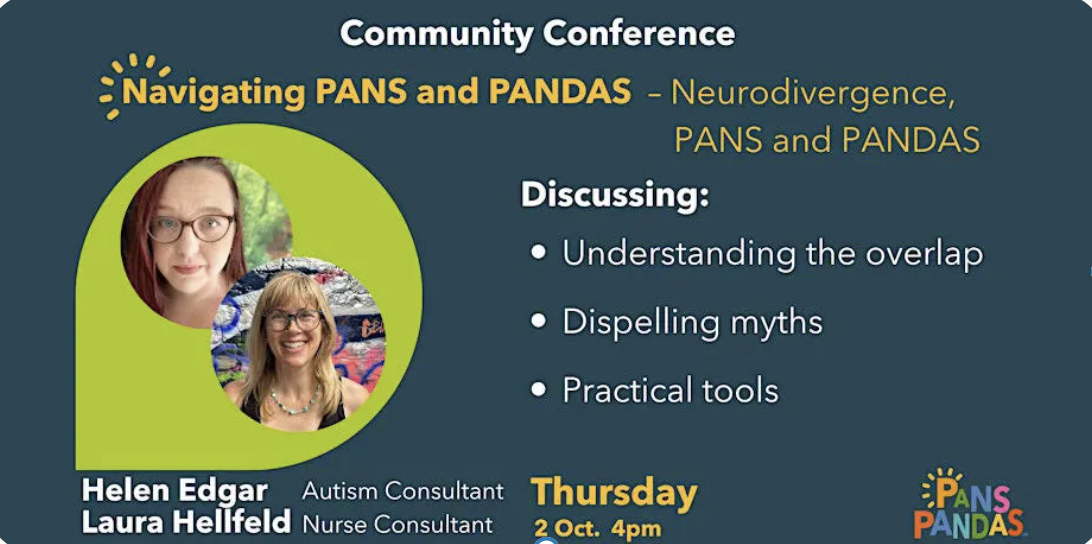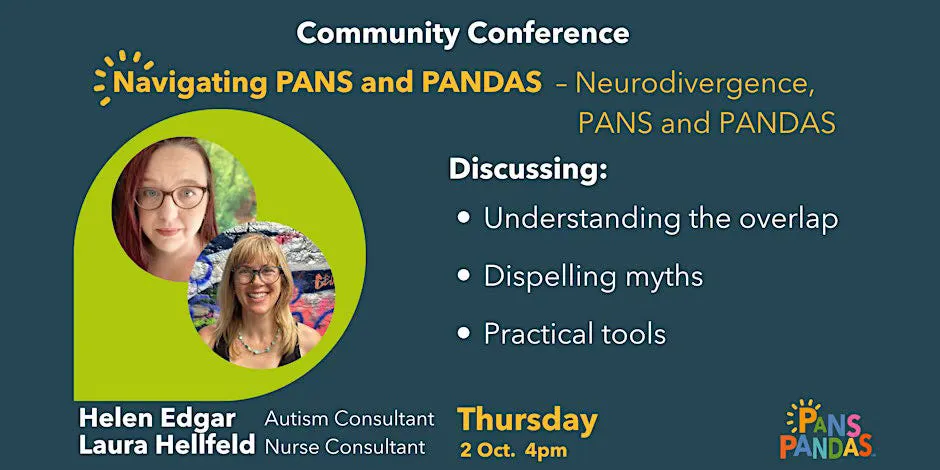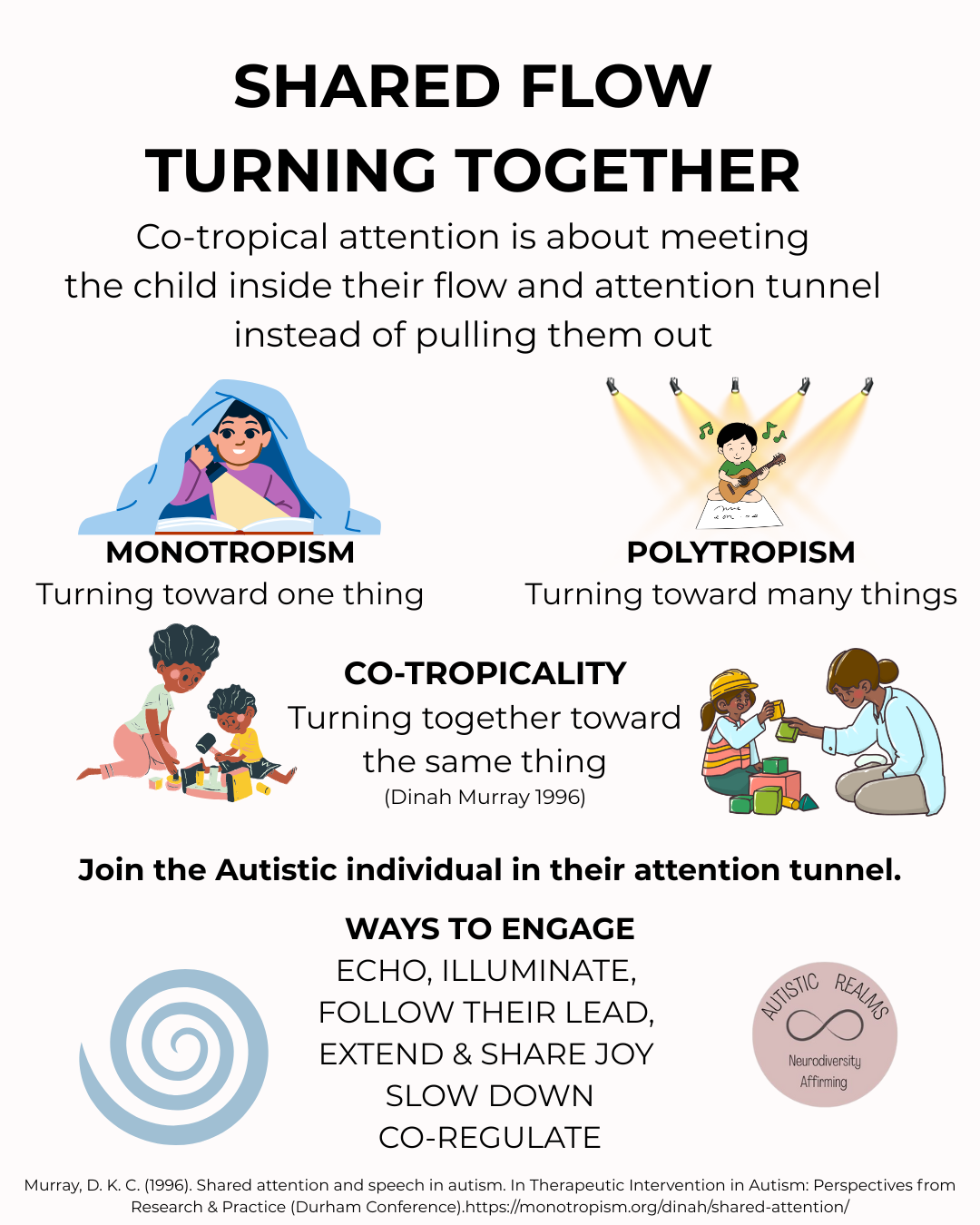Your basket is currently empty!

Navigating PANS/PANDAS & Neurodivergence
Laura Hellfeld and I spoke at the October 2025 PANS/PANDAS UK Conference, hosted by the PANS/PANDAS UK charity. Our session, Neurodivergence, PANS & PANDAS, explored what PANS and PANDAS are, what neurodivergence means in this context, and the overlaps between them. We highlighted the risks of diagnostic overshadowing and shared practical strategies and tools that parents, carers, and educators can use straight away to create more supportive environments for children and young people.
Our webinar will be hosted on the PANS/PANDAS Conference webpage for future listening/watching.
As part of our preparation, Laura developed three information-gathering templates which I supported. These are designed to help parents, carers, and education staff track symptoms, spot patterns, and build a clearer picture of a young person’s needs. These templates can also strengthen advocacy in healthcare settings by making the realities of day-to-day experiences more visible.

Important Note
These are information gathering templates intended for use in the home or school setting. They are not a diagnostic tool and should not be used to confirm a diagnosis of PANS or PANDAS (or any other health or mental health condition). These conditions are diagnosed by exclusion and require assessment by a qualified medical professional.
The templates may be helpful to identify traits or concerns that could be consistent with PANS or PANDAS, but it must be considered alongside a broader range of clinical, and contextual information. The purpose of the templates are to support awareness and guide further investigation, not to provide a diagnosis.
Parents, Carers & Families, Health & Behaviour Journal
Purpose
This tool helps you track and organise concerns about your young person’s health and daily functioning. PANS and PANDAS can involve changes across many areas of life from mood and behaviour to sleep, learning, eating, toileting and fine and gross motor skills. Recording these changes can help you notice patterns, give clearer information to health professionals, and support ongoing care.
Key words to keep in mind when recording are spikes, intensity, and changes to baseline. These highlight when symptoms appear suddenly, how strong they are, and how they differ from what is typical for the young person.
Education Staff, Health & Behaviour Journal
Purpose
This tool helps staff track and organise concerns about a student’s health, learning, and daily functioning in the school environment. PANS and PANDAS can involve sudden changes across many areas of life, including mood, behaviour, sleep, learning, eating, toileting, motor skills, and social participation.
Recording these changes in school can:
- Provide clearer information to parents/carers and health professionals.
- Support planning reasonable adjustments.
- Help staff notice patterns or flares that may impact learning and wellbeing.Keep in mind the keywords spikes, intensity, and changes to baseline. These highlight when symptoms appear suddenly, how strong they are, and how they differ from what is typical for the student.
Individual & Family Health Organiser
Purpose
This tool helps you collect and organise key family health information that may be relevant to your or your young person’s wellbeing. Many conditions (e.g., autoimmune issues, allergies, digestive concerns) can run in families, and sharing this context with health professionals can make it easier to get the right support. We also recognise that families are diverse, and it may feel complicated to gather or share this information. Please include what feels possible for you while respecting the privacy and wishes of relatives.
Laura Hellfeld (RN, MSN, PHN, CNL) wrote this article and created the resources. I edited the article for Autistic Realms in October 2025 and supported the development of Laura’s resources.
Connect with Laura on social media:
LinkedIn, Instagram, Facebook and BlueSky
Disclaimer: The information shared in this blog is for informational purposes only and is not intended to replace medical advice, diagnosis, or treatment. Please consult a licensed healthcare provider for personalised support and care tailored to your specific needs.
Signposting and Resources
- PANS/PANDAS UK
- PANS/PANDAS frequently asked questions
- PANS Life Facebook page
- PANS Australia and PANS Australia Facebook page
- PANS PANDAS Foundation Ireland
- PANS PANDAS Education with Shara Virlan
The following list was collated and shared by Romy Worthington
- Romy’s PANDAS/PANS and OCD Youtube Playlist: https://www.youtube.com/playlist?list=PL39925jJXko0mAIEKiO9k9TwOdKl9tJ4M
- Romy’s Instagram page with a lot of PANDAS/PANS posts: https://www.instagram.com/chronic.advocate?utm_source=ig_web_button_share_sheet&igsh=ZDNlZDc0MzIxNw==
- Information on antibiotics for PANDAS/PANS: https://www.pandasppn.org/antibiotics/
- Royal College of Nursing PANDAS/PANS information: https://www.rcn.org.uk/news-and-events/Blogs/pans-pandas-a-mysterious-and-debilitating-paediatric-disorder-180523
- When specific foods trigger brain inflammation in children: https://www.lymedisease.org/members/lyme-times/2023-summer-news/foods-trigger-brain-inflammation/
- Patient stories of brain inflammation: https://braininflammation.org/patient-stories/
- A parent talking about the importance of antiviral treatment when antibiotics don’t work: https://www.linkedin.com/posts/emiliametzel_weeklypans-activity-7192897265559097344-fDqn?utm_source=share&utm_medium=member_desktop
- Food Sensitivities: https://theconversation.com/people-can-have-food-sensitivities-without-noticeable-symptoms-long-term-consumption-of-food-allergens-may-lead-to-behavior-and-mood-changes-192570
- Finding a doctor:
- The Children’s E-hospital, Dr Ubhi: https://drtimubhi.com
- PANS PANDAS UK Facebook group: https://aspire.care/treating-pans/medications/
- Information on false FII allegations: https://panspandasuk.org/support-resources/safeguarding-and-fii/
- Stanford medicine PANS PANDAS Q&A: https://med.stanford.edu/pans/about/Q-and-A.html
- A Q&A with an expert on PANS and Lyme: https://neuroimmune.org/dr-shannon-delaney-interview/
- Info on Lyme testing: https://arminlabs.com/en/diseases/bacteria/lyme-borreliosis
- PANS PANDAS UK facebook group: https://www.facebook.com/groups/189721514954497
Find out more about Neurodivergence and PANS/PANDAS
Latest Posts
-
Autistic Burnout – Supporting Young People At Home & School

Autistic burnout in young people is real—and recovery starts with understanding. This post offers neuroaffirming ways to spot the signs, reduce demands, and truly support. 💛 #AutisticBurnout #Neuroaffirming #Monotropism #AutisticSupport
-
Monotropic Interests and Looping Thoughts

The theory of monotropism was developed by Murray, Lawson and Lesser in their article, Attention, monotropism and the diagnostic criteria for autism (2005). Monotropism is increasingly considered to be the underlying principle behind autism and is becoming more widely recognised, especially within autistic and neurodivergent communities. Fergus Murray, in their article Me and Monotropism:…
-
Map of Monotropic Experiences

Monotropism seeks to explain Autism in terms of attention distribution and interests. OSF Preprints | Development and Validation of a Novel Self-Report Measure of Monotropism in Autistic and Non-Autistic People: The Monotropism Questionnaire This map highlights 20 common aspects of my personal monotropic experiences. How many do you experience? Where are you on the map…
-
Autistic Burnout – Supporting Young People At Home & School

Being autistic is not an illness or a disorder in itself, but being autistic can have an impact on a person’s mental and physical health. This is due to the often unmet needs of living in a world that is generally designed for the well-being of people who are not autistic. In addition, three-quarters of…
-
The Double Empathy Problem is DEEP

“The growing cracks in the thin veneer of our “civilised” economic and social operating model are impossible to ignore”, Jorn Bettin (2021). The double empathy problem (Milton, 2012) creates a gap of disconnect experienced between people due to misunderstood shared lived experiences. It is “a breakdown in reciprocity and mutual understanding that can happen between people…
-
Top 5 Neurodivergent-Informed Strategies

Top 5 Neurodivergent-Informed Strategies By Helen Edgar, Autistic Realms, June 2024. 1. Be Kind Take time to listen and be with people in meaningful ways to help bridge the Double Empathy Problem (Milton, 2012). Be embodied and listen not only to people’s words but also to their bodies and sensory systems. Be responsive to people’s…
-
Autistic Community: Connections and Becoming

Everyone seeks connection in some way or another. Connections may look different for autistic people. In line with the motto from Anna Freud’s National Autism Trainer Programme (Acceptance, Belonging and Connection), creating a sense of acceptance and belonging is likely to be more meaningful for autistic people than putting pressure on them to try and…
-
Monotropism, Autism & OCD

This blog has been inspired by Dr Jeremy Shuman’s (PsyD) presentation, ‘Neurodiversity-Affirming OCD Care‘ (August 2023), available here. Exploring similarities and differences between Autistic and OCD monotropic flow states. Can attention tunnels freeze, and thoughts get stuck? Autism research is shifting; many people are moving away from the medical deficit model and seeing the value…
-
Monotropism Questionnaire & Inner Autistic/ADHD Experiences

Post first published 28th July 2023 Over the past few weeks, there has been a sudden surge of interest in the Monotropism Questionnaire (MQ), pre-print released in June 2023 in the research paper ‘Development and Validation of a Novel Self-Report Measure of Monotropism in Autistic and Non-Autistic People: The Monotropism Questionnaire.‘ by Garau, V., Murray,…
-
Penguin Pebbling: An Autistic Love Language

Penguin Pebbling is a neurodivergent way of showing you care, like sharing a meme or twig or pretty stone to say “I’m thinking of you,” inspired by penguins who gift pebbles to those they care about.
-
Navigating PANS/PANDAS & Neurodivergence

Our new PANS/PANDAS info-gathering templates help families, schools & clinicians understand the overlap between neurodivergence and PANS/PANDAS.
-
Shared Flow: Turning Attention To Support Children Together

Discover Dinah Murray’s concept of co-tropicality—turning our attention together. Explore how joining Autistic children in their flow builds trust, co-regulation, and deep relational connection through shared focus and joy.
-
Protecting the Meaning of Neuro-Affirming Practice

Discover what genuine neuro-affirming practice looks like — beyond tokenism and “neurodiversity-lite.” Explore how to protect the heart of the neurodiversity movement and uphold its community-led roots.












